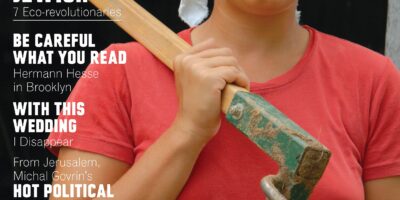Outdoor Educator: Nili Simhai, 35
Director Of The Teva Learning Center, She Teaches Judaism Through The Lens of Nature.
I grew up in a Farsi-speaking family, first in Israel, then Teheran, and finally in Cleveland, where I attended a Hebrew Day School. I was one of those kids who just always taught Hebrew on the side. I loved being Jewish. Another part of me was passionate about nature; nothing made me happier than being with my cats in our little suburban backyard. I majored in Wildlife Management at Ohio State, and my folks thought I was crazy. “This is not a career,” was my father’s line. “It’s a hobby.” I assumed I’d get a doctorate and do research, but then one summer I taught at a nature center. “This is it,” I thought. “I was meant to teach.”
So there I was, shomer Shabbat [an observant Jew], flipping through an environmental job catalogue and thinking, “If only I could combine this with being Jewish!” I literally turned the page at that moment, and there it was: “Jewish Environmental Educators Wanted.” And that’s how I got to Teva. I’ve been here 10 years.
At Teva, we teach Jewish studies — the holidays, prayer, Jewish values — in contact with God’s creation. Teva does weeklong and Shabbat retreats — for Jewish Day Schools, for groups of bar/bat mitzvah kids, for families; synagogue life is no longer just “Hebrew School” or “Men’s Clubs.” We teach about 3000 people a year — in the summer in Cold Spring, New York, in the fall in Falls Village, Connecticut, and in the spring we move the whole show to Baltimore. We sponsor a four-day conference every year, and we send educators out to whomever wants us. At the height of our year, we have 18 to 20 people teaching, most of them 20-somethings. We’ve grown into being such a rich and supportive community.
The sort of thing we do is, say, blindfold students and then walk them to a scenic overlook. “Say the first word that comes to your mind,” we instruct them, and then we whip off the blindfold. “Wow.” “Oooohhh.” “Spectacular!” We let them soak it in for a little while. Then we say, “Did you know there’s a traditional bracha [prayer] for moments of awe like this?” At that moment one of two things happens: Either something comes alive for them in Judaism, or something comes alive for them in nature.
At Gesher Jewish Day School in Fairfax, Virginia, we’re constructing a curriculum that can be used outdoors for teaching everything — Mishna, science, tefilla [prayer]. We’re planting a “Hagim [holidays], Shabbat and Havdalah Garden” — the Havdalah one full of herbs; the Shabbat one full of different flowers. And we have a Rosh HaShana curriculum tied to composting — teaching tshuva [repentance] through parallels with the compost bin. Jewish biblical and Talmudic texts are just stuffed with agriculture and nature.
The ripple effect — I really believe in it. You teach people, they go out into the world and teach people, and then these people teach people, and on and on into new communities. We all work from such a place of joy. I think the synergy of faith and nature makes you joyful.
Nili, whom would you like to invite into Lilith’s sukkah?
Rabbi Fred Scherlinder Dobb. He was walking across the country as part of an interfaith group whose mission it was to raise environmental awareness. I was in 11th grade. He stopped at a local shul to give a talk. Some part of my mind never forgot this.
Who’s been a significant role model?
Whoever wrote, “Vocation is where the heart’s deep gladness meets the world’s deep hunger.”
What shakes your lulav?
Once I was backpacking and I found this huge purple caterpillar that did backflips when you held it in your hand. I was exhausted and hungry, but I shouted a bracha [prayer]. It was the most real prayer I ever said in my life.
The Earth is a fragile sukkah. What one act of repair can we offer?
Take a hike on Shabbos and say a prayer — either a traditional one, or one you make up yourself.


